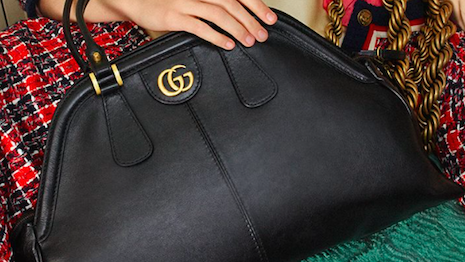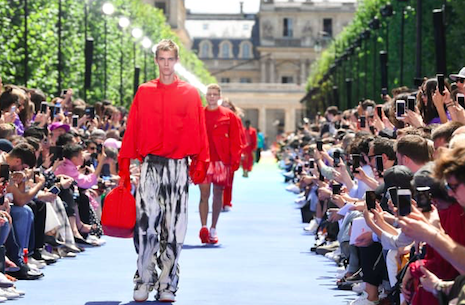 Under Alessandro Michele, Gucci has veered to exuberant garden motifs with fashion shows heavily dosed with ghoul, with resulting record sales affirming that consumers have saluted that tack. Image credit: Gucci, Facebook
Under Alessandro Michele, Gucci has veered to exuberant garden motifs with fashion shows heavily dosed with ghoul, with resulting record sales affirming that consumers have saluted that tack. Image credit: Gucci, Facebook
By Susanna Nicoletti Gucci CEO Marco Bizzarri recently announced that Gucci aims to reach €10 billion ($11.7 billion) in revenue in the near future. In 2017, the brand reached a peak of €6.2 billion ($7.2 billion) with a growth rate of 42 percent compared to the previous year. The brand's obvious target is Louis Vuitton, owned by competitor luxury group LVMH. It is a battle of giants that is fiercely fought by both sides with totally different approaches to brand management. Louis Vuitton’s brand strategy is based on:
- Long-term management. Yves Carcelle successfully managed the brand for more than 20 years. Michael Burke, who joined the company from Bulgari, was appointed CEO of Vuitton in 2012 and he is one of the executives closest to Bernard Arnault, LVMH founder/CEO.
- Multi-designer approach. Every category of products has a creative director: Nicolas Ghesquière for women’s, Virgil Abloh for men's, and Francesca Amfitheatrof for watches and jewelry. This multi-voice approach helps develop a fresh brand vision and a mosaic brand image that enriches the storytelling.
- Directly-operated stores. The company, according to its profile on Business of Fashion, has 460 mono-brand, directly-operated stores in the world.
- No wholesale
- No discount policy
- No outlets
- Founded in 1854, it has around 10,000 employees globally
- Both women’s cruise collections developed by Mr. Ghesquière and shown at the Foundation Might at Saint Paul-de-Vence were inspired by the French Riviera lifestyle and the men’s collection that saw the debut of Mr. Abloh in the gardens of Palais Royal were inspired by light, brightness, joie de vivre and a very contemporary attitude. Colorful yet sophisticated, both collections developed a strong approach to fashion and luxury with great attention to detail, color palette and shapes, but also with a connection to the coolest trends of the moment.
- Brand first.
- Higher turnover at CEO level. Mark Lee's tenure at Gucci lasted four years (2004-08) and he was considered by WWD “one of the industry’s most admired executives — who grew Gucci revenues 46 percent during his four-year tenure but saw its rise wobble." Patrizio Di Marco (who then married the brand creative director Frida Giannini) stayed on board until 2014, then Marco Bizzarri joined in 2014. In an interview to Italian newspaper Corriere della Sera, he said that “a CEO must leave his post after five to six years’ tenure, otherwise he risks to be overwhelmed by self-gratification.” This high turnover gives strong shots of energy to the brand and high growth rates but also puts it at risk of rapid exhaustion.
- Monolithic creative direction. Following Tom Ford's forced departure, both Ms. Giannini and her successor, Alessandro Michele, took the reins overlooking all the product categories developed by the brand and giving to it their strong and distinctive imprint, starting from scratch with their own personal brand development.
- Designer centric
- Established in 1921, it has around 11,500 employees
- There are 529 directly-operated stores, a wholesale network and quite a relevant network of outlets
- The last cruise collection depicted a very dark vision of the brand, including a nighttime show in Arles in an ancient cemetery full of esoteric symbols displayed on the products. Mr. Michele's obsession for the dark world and for death was clearly represented in this event marked by church bells and night walks fiery catwalks.
 Helmed by many creative chiefs, Louis Vuitton marketing and merchandise for its different lines displays a light touch of French elegance and joy of life. Image credit: Louis Vuitton
Helmed by many creative chiefs, Louis Vuitton marketing and merchandise for its different lines displays a light touch of French elegance and joy of life. Image credit: Louis Vuitton
 Susanna Nicoletti is founder and senior director of LuxFashionHotspot
Susanna Nicoletti is founder and senior director of LuxFashionHotspot
